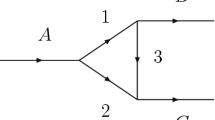Abstract
Triangle mechanisms for \(B^0\rightarrow (J/\psi \pi ^+\pi ^-) K^+\pi ^-\) are studied. Experimentally, an X(3872) peak has been observed in this process. When the final \((J/\psi \pi ^+\pi ^-)\pi \) invariant mass is around the \(D^*\bar{D}^*\) threshold, one of the triangle mechanisms causes a triangle singularity and generates a sharp X(3872)-like peak in the \(J/\psi \pi ^+\pi ^-\) invariant mass distribution. The Breit–Wigner mass and width fitted to the spectrum are 3871.68 MeV (a few keV above the \(D^{*0}\bar{D}^0\) threshold) and \(\sim \) 0.4 MeV, respectively. These Breit-Wigner parameters hardly depend on a choice of the model parameters. Comparing with the precisely measured X(3872) mass and width, \(3871.69\pm 0.17\) MeV and \(< 1.2\) MeV, the agreement is remarkable. When studying the X(3872) signal from this process, this non-resonant contribution has to be understood in advance. We also study a charge analogous process \(B^0\rightarrow (J/\psi \pi ^0\pi ^-) K^+\pi ^0\). A similar triangle singularity exists and generates an \(X^-(3876)\)-like peak.




Similar content being viewed by others
Notes
The triangle diagrams of Fig. 1a–d will be refereed to as diagrams A, B, C, and D, respectively.
References
S.K. Choi et al., Belle collaboration. Phys. Rev. Lett. 91, 262001 (2003)
F.-K. Guo, X.-H. Liu, S. Sakai, Prog. Part. Nucl. Phys. 112, 103757 (2020)
S.X. Nakamura, K. Tsushima, Phys. Rev. D 100, 051502(R) (2019)
S.X. Nakamura, Phys. Rev. D 100, 011504(R) (2019)
A. Bala et al., Belle collaboration. Phys. Rev. D 91, 051101(R) (2015)
S.X. Nakamura, Phys. Rev. D 102, 074004 (2020)
F.-K. Guo, Phys. Rev. Lett. 122, 202002 (2019)
M. Tanabashi et al., Particle data group. Phys. Rev. D 98, 030001 (2018)
H. Kamano, S.X. Nakamura, T.-S.H. Lee, T. Sato, Phys. Rev. D 84, 114019 (2011)
Author information
Authors and Affiliations
Corresponding author
Additional information
Publisher's Note
Springer Nature remains neutral with regard to jurisdictional claims in published maps and institutional affiliations.
This work is in part supported by National Natural Science Foundation of China (NSFC) under contracts U2032103 and 11625523, and also by National Key Research and Development Program of China under Contracts 2020YFA0406400.
Rights and permissions
About this article
Cite this article
Nakamura, S.X. An X(3872)-Like Peak in \(B\rightarrow (J/\psi \pi ^+\pi ^-) K\pi \) Due to Triangle Singularity. Few-Body Syst 62, 40 (2021). https://doi.org/10.1007/s00601-021-01623-2
Received:
Accepted:
Published:
DOI: https://doi.org/10.1007/s00601-021-01623-2




